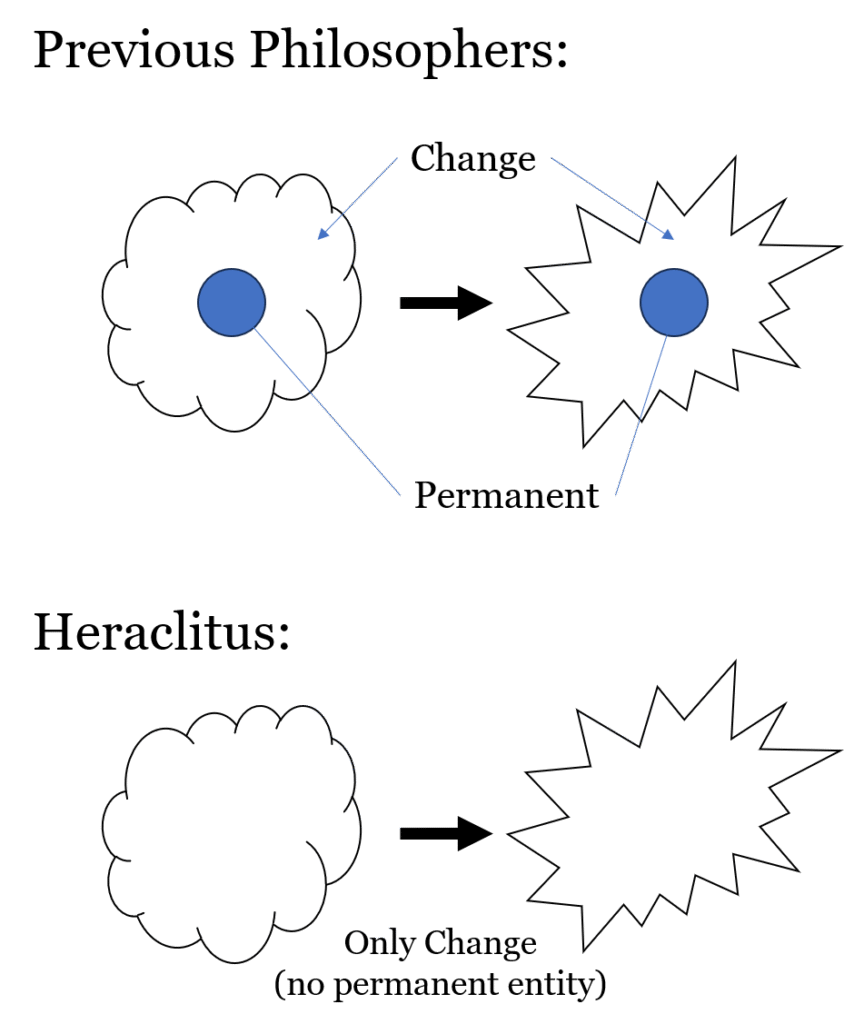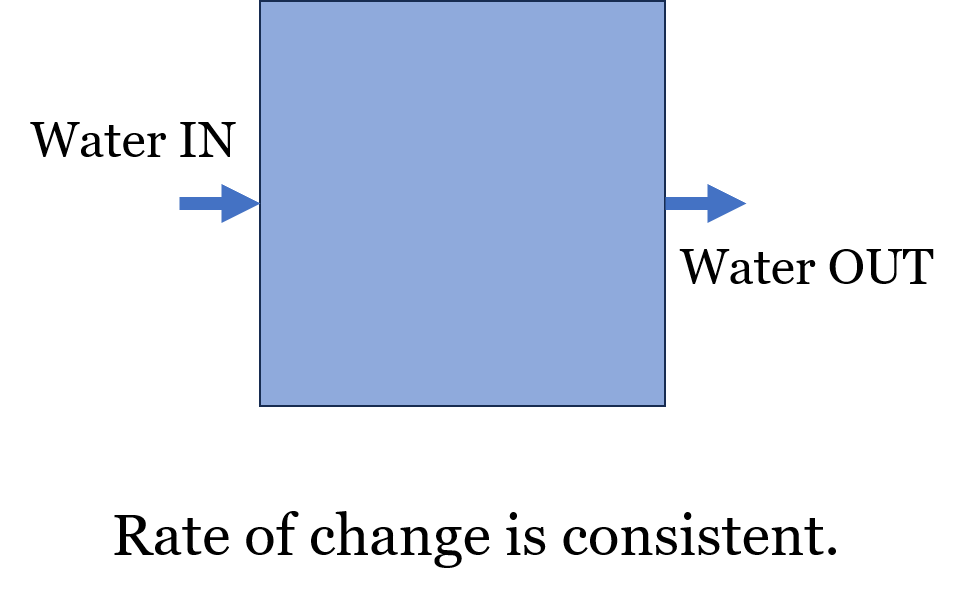Easy revision notes on Heraclitus. Learn about flux, fire, logos, and unity of opposites with clear explanations for students.
Table of Contents
Heraclitus: Life and Writings
- Heraclitus was an ancient Greek philosopher, born around 540 BC and died around 480 BC (approximate dates).
- He was born in the Ionian city of Ephesus and lived there his whole life.
- Nearby cities were Colophon (Xenophanes), Miletus (early philosophers), and Samos (Pythagoras).
- He came from a royal and noble family.
- He was known as proud and arrogant, which is also visible in his writings.
- Compared to earlier philosophers, more of Heraclitus’ writings are available today.
- His style was unusual: he wrote in short aphorisms (brief, deep sentences) instead of continuous arguments.
- Around 100 aphorisms survive, each needing meditation and reflection to understand their hidden meaning.
- Because of this style, he was called “the dark one,” “the riddler,” and “the obscure.”
- He wrote a book and placed it in the Artemis temple; Socrates later read it.
- Socrates said the book was so deep that only a “deep sea diver” could fully understand it.
- Heraclitus may have written in a puzzling way because he distinguished between knowledge and wisdom.
- For him, wisdom cannot be gained only by reasoning or knowledge, but through inspiration.
- His writings confuse and challenge, leading the reader toward wisdom.
- The aim of philosophy, according to this approach, is not knowledge but wisdom (love of wisdom).
- Heraclitus criticized many respected thinkers like Homer, Hesiod, Anaximander, Pythagoras, and Xenophanes.
- He believed they had knowledge but lacked true wisdom.
- His arrogance carried a message: reject fake knowledge and seek real wisdom.
- Heraclitus deeply influenced many later thinkers: Stoics, Socrates, Plato, Aristotle, Hegel, Nietzsche, Heidegger, Deleuze, Foucault, David Bohm, and others.
- His writings are divided into three parts: nature, politics, and religion.
Summary:
Heraclitus, a Greek philosopher from Ephesus, was proud and unique in style. He wrote in short, deep aphorisms, earning names like “the obscure.” For him, philosophy aimed at wisdom, not just knowledge. He criticized even great thinkers and strongly influenced later philosophy. His writings are grouped into nature, politics, and religion.
Heraclitus on Nature and Reality
- Heraclitus said that reality is a flux, meaning continuous change and flow.
- He used fire as a symbol of this constant change.
- To understand his idea, we must see the context: he was responding to earlier philosophers.
- Thales asked: what is the fundamental principle of the world?
- Example: gold can change form (coin, ring, etc.), but remains the same gold.
- Example: water can change states (liquid, ice, steam), but is still water.
- These examples suggest that behind all change, there is something permanent that gives identity.
- People naturally feel that behind all forms of change there must be a permanent entity.
- Milesian philosophers called this the fundamental principle or fundamental stuff.
- They believed all things come from this one base, and visible changes are just modifications of it.
- Key questions were:
- What is this fundamental stuff?
- How does it transform into many different things?
- Thales said it was water, Anaximenes said air, and Xenophanes said earth.
- But none could explain how this stuff transforms into many forms. This is the problem of one and many.
- Anaximander proposed apeiron (the boundless) as the principle, without properties, since properties imply change.
- Yet he also could not solve the problem of how it transforms into different things.
Summary:
Heraclitus described reality as continuous change, symbolized by fire. He was responding to earlier thinkers who searched for one permanent substance behind all forms. Philosophers like Thales, Anaximenes, Xenophanes, and Anaximander gave answers (water, air, earth, apeiron), but none fully solved the problem of how the one becomes many.
Process as Fundamental Reality
- Heraclitus understood that as long as reality is seen as one material substance, the problem of unity and diversity cannot be solved.
- He said fundamental reality is not matter or stuff, but a process or pattern.
- This shift from “stuff” to “process” solves the problem of the one and the many (unity in diversity).
- All diversity in the world is unified by this ongoing process.
- The process is change, but not random — it is ordered change according to measures.
- This continuous, ordered change is called flux, symbolized by fire.
- Change is eternal: it has always existed, exists now, and will always exist.
- To understand this eternal flux is true wisdom.
- Earlier thinkers (Milesians) believed in permanent material substances like air or water.
- Heraclitus rejected permanence as illusion and insisted reality is only process and change.
- He called other philosophers ignorant because they searched for permanent matter instead of seeing flux as reality.
- Example: weather. Weather is not a fixed thing but a collection of processes (temperature, humidity, wind, etc.), all continuously changing.
- For earlier philosophers, objects had two aspects: change and permanence.
- For Heraclitus, there is only one aspect: change. Nothing remains fixed or permanent.
- He explained with the river example: “You cannot step into the same river twice.”
- A river constantly flows, so it is never the same at two different moments.
- The name “river” remains, but the actual physical entity is always changing.
- Later thinkers extended this: humans too are like rivers.
- We change physically and mentally over time, so in one sense, we are never the same person we once were.
Summary:
Heraclitus replaced the idea of a permanent substance with the idea of reality as process. For him, reality is eternal change (flux), symbolized by fire. Permanence is only an illusion; everything, including rivers and humans, is in constant transformation. True wisdom is understanding this continuous process.
Identity and Continuity in Heraclitus

- Heraclitus changed philosophy in three key ways:
- The fundamental principle is not matter or stuff, but a process.
- Change is real, while permanence is only an illusion.
- Identity is explained through continuity of process, not permanence of substance.
- Earlier philosophers thought something permanent existed within change (e.g., water in different states).
- Heraclitus said nothing is permanent; everything is in flux, so change itself is reality.
- The question then arises: if everything changes, how can we identify anything?
- His answer: identity depends on the continuity of process, not on a fixed element.
- Example: fire. Fire is never fixed, it is always burning in and burning out.
- Yet we still identify it because the process continues without gaps.
- Continuity of process = the source of identity.
- Two models of identity:
- Continuity of subject: a fixed thing continues (earlier philosophers).
- Continuity of process: an unbroken process continues (Heraclitus).
- Reality seems stable because the rate of change is constant.
- Example: a swimming pool where water enters and exits at the same rate. The water changes fully, but it looks the same.
- Fire and rivers also appear stable for the same reason — constant replacement.
- Heraclitus stressed that this is not ordinary visible change (like weather changes), but a deeper, constant change happening all the time.
- Everything, including objects like a pen, is continuously changing even if it looks permanent.
Summary:
Heraclitus argued that reality is continuous change, not permanence. Identity comes from the unbroken continuity of process, not from fixed substance. Things appear stable because change happens at a constant pace, making flux look like permanence.
Flux, Modern Science, and Unity of Opposites

- Heraclitus’ idea of flux is very modern. Philosophers and scientists have long searched for something permanent in the world, but every step has changed this concept.
- First, creation and destruction were seen as rearrangements of atoms, thought to be permanent and indestructible.
- Later, it was found that atoms can be divided into smaller particles (electrons, protons).
- Then, discoveries showed these particles can convert into energy.
- This shifted permanence from matter to energy.
- Energy is not physical matter; it is more like a process or interaction, similar to Heraclitus’ flux or fire.
- Bertrand Russell expressed this by saying in modern physics “what burns” has disappeared, leaving only the process of burning.
- Focus is no longer on substances like water, air, or earth, but on process, change, and flux.
- On this base, Heraclitus developed the idea of the unity of opposites.
- Earlier philosophers (Anaximander, Pythagoras, Homer) saw opposites like hot/cold, wet/dry, day/night, good/bad as forces in conflict.
- Heraclitus said these opposites are not enemies but complementary, maintaining harmony and stability in the world.
- Example: fire. Burning-in and burning-out are opposites, yet together they sustain the fire.
- Example: swimming pool. Water flows in and out at the same rate. These opposite movements keep the pool stable.
- Flux means creation and destruction happen together, balancing each other and creating order.
- Before Heraclitus, opposites were viewed destructively (leading to conflict or ruin).
- For Heraclitus, opposites are constructive, bringing balance, harmony, and creation.

Summary:
Heraclitus’ vision of flux aligns with modern science, where permanence is no longer matter but energy, understood as process. He extended this to the idea of unity of opposites: creation and destruction, in-flow and out-flow, burning-in and burning-out all work together to maintain harmony. Opposites are not destructive but essential for balance and stability.
Unity of Opposites in Heraclitus
- Heraclitus explained the unity of opposites using three types of examples: perception, temporal process, and struggle.
Perception Examples
- “The path traced by the pen is straight and crooked.” Writing appears straight as a sentence, but curved as letters.
- Sea water is both pure and impure: drinkable for fish but undrinkable for humans.
- “The path up and the path down are the same.” The same road serves both directions.
- These show that one thing can carry two opposite properties at the same time.
Temporal Examples
- Day and night, summer and winter, war and peace, good and bad, life and death are one.
- These opposites are not simultaneous but follow each other in a process of change.
- Opposites belong to the same larger cycle, forming unity through sequence.
Struggle Examples
- The lyre (musical instrument) has tension between frame and strings.
- This tension or struggle produces harmony and music.
- Similarly, world order and stability depend on the creative balance of opposites.
- Opposites are not destructive but constructive, making order possible.
- The reason for using three types of examples is unclear.
- Perhaps Heraclitus meant opposites depend on perception, or all opposites are part of one larger process, or something even deeper.
- His aphorisms are riddles designed to confuse, challenge, and push readers to think beyond fixed assumptions.
- Like Kant said about Hume awakening him from “dogmatic slumber,” Heraclitus’ writings also awaken critical reflection.
Summary:
Heraclitus showed that opposites are not enemies but part of harmony. Through examples of perception, time, and struggle, he explained that opposites can exist together, follow each other, or create balance. His aphorisms force readers to think deeply, making us realize that stability comes only from the unity of opposites.
Heraclitus on Logos: Order and Law
- For Heraclitus, flux (change) is not random but an ordered process.
- This order is governed by Logos, a universal principle that controls and manages the cosmos.
- Logos is the reason, logic, or law behind all change.
- Understanding Logos = true understanding and true wisdom.
- Logos explains why the world looks stable even though it is in constant flux.
- Opposite forces work together in harmony because of Logos.
- Logos is a hidden order: invisible, without gaps or errors, yet always present.
- In language, the word logos has many meanings: word, message, thought, rational order, or argument.
- The word “logic” comes from Logos, and so do terms like psychology, biology, sociology.
- In the Bible, Logos is also mentioned: “In the beginning was the Logos…”
- But Heraclitus used Logos mainly to mean reason or universal law.
- Heraclitus said Logos is very difficult to understand, and only a few truly grasp it.
- He divided people into three categories:
- Those who fully understand Logos (including himself).
- Those who do not know Logos directly but use it unconsciously through reasoning.
- Those “asleep,” who neither know nor use Logos, living in darkness.
- In studying philosophy, ideas must be connected, not isolated.
- For Heraclitus:
- Context → Flux → Identity → Unity of Opposites → Logos.
- Logos unifies all these into one single ordered process.
Summary:
Heraclitus’ concept of Logos means the universal law or reason that governs all change. Logos makes flux stable, harmonizes opposites, and forms the hidden order of the cosmos. Few people truly understand it, but recognizing Logos is the path to wisdom. It connects all of Heraclitus’ main ideas into one complete system.
Core Concepts of Heraclitus’ Philosophy
- Four main concepts in Heraclitus: Flux, Fire, Unity of Opposites, and Logos.
- Flux: Everything is changing, nothing is permanent.
- Fire: Symbol of reality’s dynamic and changing nature.
- Unity of Opposites: Opposing forces depend on each other and create balance, harmony, and stability.
- Logos: A rational principle or cosmic law that organizes, maintains, and orders the world; a hidden foundation of all processes.
How these concepts changed philosophy
- The fundamental principle is not material stuff but a process (similar to energy, not matter).
- Change is real, permanence is only an illusion.
- Identity of any object is based on continuity of process, not fixed substance.
- Opposite forces are constructive, not destructive; they maintain balance and harmony.
- The “one and many” problem is resolved: plurality is not separate, but part of the single cosmic process. Reality is one.
Summary:
Heraclitus transformed philosophy with four key ideas: flux, fire, unity of opposites, and logos. He showed that change is real, permanence is illusion, identity comes from process, opposites create harmony, and all diversity belongs to one cosmic order.
Selected Fragments and Quotes of Heraclitus
On Cosmos and Fire
- “This ordered universe, which is the same for all, was not created by any god or man. It always was, is, and will be an ever-living fire, kindled in measures and quenched in measures.”
- The universe is eternal, not created.
- Its nature is fire, symbolizing flux and change.
- Change happens according to measure — pointing to Logos (universal law).
On Flux and Opposites
- “All things come into being through opposition, and all are in flux, like a river.”
- Opposites are the basis of all existence.
- The world is a constant flux, like a flowing river.
On Strife and Necessity
- “War is universal, and justice is strife. All things take place in accordance with strife and necessity.”
- Conflict (war/strife) is fundamental to reality.
- Struggle between opposites creates change, growth, and harmony.
- Strife works within a framework of necessity — natural law or Logos.
- The world’s flux results from an ordered struggle of opposites.
On Ethics and Human Life
- “It is not good for men to get all they wish.”
- Fulfillment of every desire is not true good.
- Balance between satisfaction and limitation is essential.
- “If happiness consisted in bodily pleasures, we ought to call oxen happy who find vetch to eat.”
- Real happiness is not just physical pleasure.
- True human happiness lies in higher aspects like knowledge, wisdom, and life’s purpose.
Summary:
Heraclitus’ fragments show his key ideas: the eternal cosmos as fire, reality as flux, and existence based on opposites in ordered struggle. Strife and necessity together sustain harmony. His ethical fragments stress balance in desires and that true happiness goes beyond bodily pleasures, pointing toward wisdom and deeper meaning.
Heraclitus: Ethics and Practical Lessons
- “It is hard to fight against impulse; for what it wants it buys at the expense of the soul.”
- Impulses = immediate desires (anger, distraction, instant pleasure).
- Acting on them can destroy honesty, peace of mind, and long-term purpose.
- Modern systems (social media, instant shopping, breaking news, discounts) exploit these impulses for profit.
- Short-term satisfaction comes, but at the cost of the soul — focus, productivity, well-being, and true happiness are lost.
- “Moderation is the greatest virtue, and wisdom is to speak the truth and to act according to nature, giving heed to it.”
- Moderation (balance) is the highest virtue.
- Wisdom = truthfulness + living in harmony with nature.
- This teaching matches other great philosophers like Socrates, who also valued moderation.
- “The content of your character is your choice. Day by day, what you choose, what you think and what you do is who you become.”
- Character is shaped by daily choices, thoughts, and actions.
- Personal responsibility defines who you are.
Summary:
Heraclitus’ ethical insights focus on resisting impulses, practicing moderation, and shaping character through daily choices. Impulses bring temporary pleasure but harm the soul, while moderation and truth lead to wisdom. His lessons remain highly relevant in today’s fast, digital world.
Recommended Reading
- Fragments (Penguin Classics) by Heraclitus (paid link)
Disclosure: As an Amazon Associate, I earn from qualifying purchases, at no extra cost to you. Learn more.

Leave a Reply